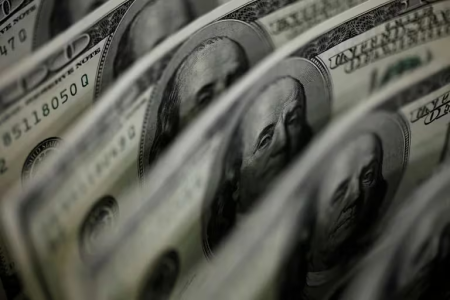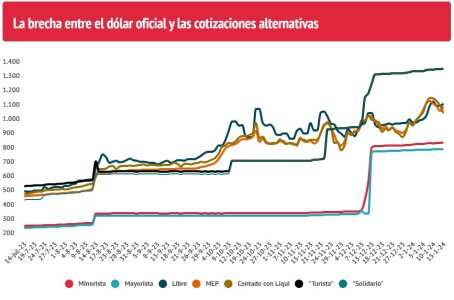antoni31
New member
Dollar or card: how to pay expenses abroad and take advantage of the exchange gap on vacation - Infobae

Source:
The difference in prices between the different free quotes of the dollar enables arbitrage, when buying MEP and paying with dollars in cash for consumption in foreign currency.

The "cash" advantage over paying the "tourist" dollar.
The “tourist” dollar for consumption with foreign suppliers is paid this Monday at $1,381.79 in the average of banks with a charge 60 percent tax. This value is today about 246.79 pesos or 21.7% more expensive than the free dollar, at 1,135 pesos for sale, and a> than the MEP dollar, at 1,118 pesos.23.6% more expensive.
This gap makes it more advantageous to pay off the card's foreign currency maturities with foreign currency drawn from the savings account in dollars. Or deposit dollars in cash to cover credit expenses.
Perceptions applied to the “tourist” dollar make travel and card expenses abroad more expensive. Although the corresponding refunds can be requested for these charges as of January 1, 2025, with an annual inflation rate that is around 200%, a significant real loss is likely before the refund of what was taxed.

For example, if it is consumed for USD 1,000 abroad, $1,381,790 is paid by card at the expiration of this January 15, of which, a 60% or 518,171 pesos correspond to taxes that can be claimed from the AFIP once the annual fiscal period has concluded.
If an inflation of 200% is assumed accumulated until the moment the refund of taxes paid in advance for payments to foreign suppliers becomes effective, this would represent at current prices 33% of what was paid a year ago, Therefore, the refund of those 518,171 pesos for 60% taxes would be equivalent to only 170,996 pesos at today's prices.
If that $170,996 is deducted from the $1,381,790 of the card payment, in the best of cases it results in a disbursement of $1,210,794 per USD 1,000, that is, a theoretical exchange rate above $1,200, still inconvenient against the MEP and the “blue” dollar.
While the “tourist” dollar or “Qatar” paid a tax burden of 80 percent until July 2023, broken down into a 30% of the PAIS tax, a 45% collection on account of Profits and a 5% collection on account of Personal Assets.
It should be noted that on November 23 General Resolution 5450 of the AFIP was published, which established the increase in the perception of Profit tax for card payments, going from 45 to 100 percent. In this way, the exchange rate that was applied to card charges was: the official exchange rate plus 100% for Income Tax, plus 30% for the PAIS tax and 25% for the Income Tax. Personal Property.

Paying with a card but canceling the statement with MEP dollars is currently the cheapest option (Illustrative image Infobae)
Finally, on December 14, already under the administration of Javier Milei , it was resolved to unify the tax burden for all concepts for the retail demand for foreign currency in banks by 60%: 30% for PAIS Tax and 30% for receipt of Profits .
In general, if the card has automatic debit, all expenses will be taken in pesos and consumption in dollars will be paid at the “tourist” price. To avoid this, you have to take out the automatic debit and call the bank on the due date to take the foreign currency from the savings account to pay for consumption. of the card in currency.
The AFIP allows the deposit and withdrawal of amounts less than USD 10,000 or its equivalent in another currency. If the entry of a higher amount is required, a special declaration must be made at Customs, while monetary expenditures greater than the allowed amount must be made by bank transfer. In the case of minors under 16 years of age, the limit amount is $5,000.
This type of stock exchange, through the purchase of a bond in pesos and its resale against dollars, makes it possible to acquire “blank” currencies and leave them credited in an account in the local financial system. Today the MEP is paid at $1,118 in immediate cash and although it is cheaper than the “tourism” dollar, it is not It has the possible refund of taxes from the AFIP. In its favor, there is no amount limit to buy MEP.

Source:
The difference in prices between the different free quotes of the dollar enables arbitrage, when buying MEP and paying with dollars in cash for consumption in foreign currency.

The "cash" advantage over paying the "tourist" dollar.
The “tourist” dollar for consumption with foreign suppliers is paid this Monday at $1,381.79 in the average of banks with a charge 60 percent tax. This value is today about 246.79 pesos or 21.7% more expensive than the free dollar, at 1,135 pesos for sale, and a> than the MEP dollar, at 1,118 pesos.23.6% more expensive.
This gap makes it more advantageous to pay off the card's foreign currency maturities with foreign currency drawn from the savings account in dollars. Or deposit dollars in cash to cover credit expenses.
Perceptions applied to the “tourist” dollar make travel and card expenses abroad more expensive. Although the corresponding refunds can be requested for these charges as of January 1, 2025, with an annual inflation rate that is around 200%, a significant real loss is likely before the refund of what was taxed.

For example, if it is consumed for USD 1,000 abroad, $1,381,790 is paid by card at the expiration of this January 15, of which, a 60% or 518,171 pesos correspond to taxes that can be claimed from the AFIP once the annual fiscal period has concluded.
If an inflation of 200% is assumed accumulated until the moment the refund of taxes paid in advance for payments to foreign suppliers becomes effective, this would represent at current prices 33% of what was paid a year ago, Therefore, the refund of those 518,171 pesos for 60% taxes would be equivalent to only 170,996 pesos at today's prices.
If that $170,996 is deducted from the $1,381,790 of the card payment, in the best of cases it results in a disbursement of $1,210,794 per USD 1,000, that is, a theoretical exchange rate above $1,200, still inconvenient against the MEP and the “blue” dollar.
How the “tourist” dollar changed
It should be noted that a year ago the purchase of “savings dollars” paid 65% taxes: 30% corresponding to the Para Tax an Inclusive and Solidarity Argentina (PAIS) and 35% as an advance of Profits. As of August 14, 2023, the perception of Earnings for this type of exchange increased to 45 percent cent.While the “tourist” dollar or “Qatar” paid a tax burden of 80 percent until July 2023, broken down into a 30% of the PAIS tax, a 45% collection on account of Profits and a 5% collection on account of Personal Assets.
On October 10 of 2023, the “savings” and the “tourist” dollars were unified into a single quote, with a tax burden total of 100 percent, broken down into 30% PAIS tax, 45% as advance of Earnings and 25% of Personal Assets.After the “overshooting” of the official dollar on December 13, the free dollar and the MEP give an advantage to pay expenses abroad instead of the “tourism” dollar
It should be noted that on November 23 General Resolution 5450 of the AFIP was published, which established the increase in the perception of Profit tax for card payments, going from 45 to 100 percent. In this way, the exchange rate that was applied to card charges was: the official exchange rate plus 100% for Income Tax, plus 30% for the PAIS tax and 25% for the Income Tax. Personal Property.

Paying with a card but canceling the statement with MEP dollars is currently the cheapest option (Illustrative image Infobae)
Finally, on December 14, already under the administration of Javier Milei , it was resolved to unify the tax burden for all concepts for the retail demand for foreign currency in banks by 60%: 30% for PAIS Tax and 30% for receipt of Profits .
Pay with “cash” dollars or MEP?
To avoid paying surcharges, expenses in dollars can be paid with dollars in your own bank account. Although due to the difficult access to purchasing dollar bills, paying for consumption in currency on the card in cash is not the most common option, you could opt for it and not pay taxes.In general, if the card has automatic debit, all expenses will be taken in pesos and consumption in dollars will be paid at the “tourist” price. To avoid this, you have to take out the automatic debit and call the bank on the due date to take the foreign currency from the savings account to pay for consumption. of the card in currency.
The AFIP allows the deposit and withdrawal of amounts less than USD 10,000 or its equivalent in another currency. If the entry of a higher amount is required, a special declaration must be made at Customs, while monetary expenditures greater than the allowed amount must be made by bank transfer. In the case of minors under 16 years of age, the limit amount is $5,000.
This type of stock exchange, through the purchase of a bond in pesos and its resale against dollars, makes it possible to acquire “blank” currencies and leave them credited in an account in the local financial system. Today the MEP is paid at $1,118 in immediate cash and although it is cheaper than the “tourism” dollar, it is not It has the possible refund of taxes from the AFIP. In its favor, there is no amount limit to buy MEP.

